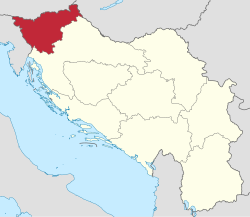Drava Banovina
| Drava Banovina Dravska banovina Дравска бановина |
|||||
| Banovina of the Kingdom of Yugoslavia | |||||
|
|||||
|
Drava Banovina (red) within Kingdom of Yugoslavia (light yellow) |
|||||
| Capital | Ljubljana | ||||
| Historical era | Interwar period | ||||
| • | January 6th Dictatorship | ||||
| • | Established | 3 October 1929 | |||
| • | Disestablished | 16 April 1941 | |||
| Area | |||||
| • | 1931 | 15,849 km2(6,119 sq mi) | |||
| Population | |||||
| • | 1921 | 1,060,356 | |||
| • | 1931 | 1,144,298 | |||
| Density | 72.2 /km2 (187 /sq mi) | ||||
| Today part of | Slovenia | ||||
The Drava Banovina or Drava Banate (Slovene: Dravska banovina) was a province (banovina) of the Kingdom of Yugoslavia between 1929 and 1941. This province consisted of most of present-day Slovenia and was named for the Drava River. The capital city of the Drava Banovina was Ljubljana.
According to the 1931 Constitution of the Kingdom of Yugoslavia,
The Drava Banovina is bounded by a line passing from the point where the northern boundary of the district of Čabar cuts the State frontier, then following the State frontier with Italy, Austria and Hungary to a point where the State frontier with Hungary reaches the river Mura (north-east of Čakovec). From the river Mura, the boundary of the Banovina follows the eastern and then the southern boundaries; of the districts of Lendava, Ljutomer, Ptuj, Šmarje, Brežice, Krško, Novo Mesto, Metlika, Črnomelj, Kočevje and Logatec, including all the districts mentioned.
Drava Banovina was administratively subdivided into 29 counties (called srez):
In 1941 the World War II Axis powers occupied the Drava Banovina, and it was divided largely between Nazi Germany and Fascist Italy, while Hungary occupied Prekmurje and the Independent State of Croatia occupied some smaller border areas.
...
Wikipedia

